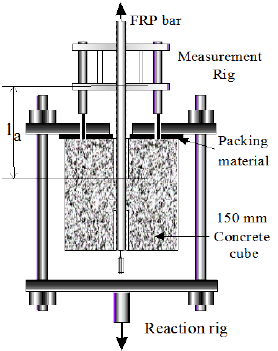How To Ascertain the Bond Strength Between Steel and Concrete by Pull Out Test
Posted on April 16, 2019
Apparatus: Rock Bolt Pull Out Test Apparatus
 Theory
Theory
Rock Bolt Pull Out Test Apparatus bond strength is basically the parameter of effectiveness of the grip that exists between the steel and the concrete and which does not have substantial definition. There exists two types of bars i.e. plain bars and deformed bars that carries the load. Therefore, it gets vital to strike a comparison between both types of bars to examine the maximum load and also the load of the arbitrary amount of slip for both types of bars. On the basis of this similarity, the relative movement (slip) load between steel as well as the concrete of 0.125 mm at the free end of the bar is determined by conducting a pull-out test.
Objective – To simply examine the bond strength between mild steel bars and cement concrete by pullout test. And within a supported concrete beam intersected reinforcement. Apparatus- Beam mould (100 mm x 150 mm x 1830 mm)
- Cylinder mould (dia = 150 mm & height = 300 mm)
- Aligning stand
- Loading reaction frame or transverse testing machine of 50 KN (5 tons)
- Pullout Test arrangement along with universal testing machine of 100 KN (10 tons)
- Graduated jar
- Platform weighing balance
- Tamping bar
- Trowels
- Concrete mixer
- Table vibrator
- Dial gauges
- Make concrete mix in a ratio of 1:2:4 along with a water cement ratio equivalent to 0.6.
- Utilizing two 10 mm bars with a covering of 12.5 mm and intersection of 200 mm in middle, cast the concrete beam having a size 100 m x 150 mm x 1830 mm. Make sure to place the three cubes along the cubes to get to know the compressing strength of the concrete.
- Place three cylinders 200 mm with a 10 mm height along with a dia rod put at the centre of the cylinder.
- Get rid of the specimens from the mould post 24 hours and put it in water. Test the beam after a period of 27 days on the 50 KN transverse testing machine.
- At 28 days age, exercise the pull-out test on universal hour testing machine of 100 KN by making use of pull out test attachment.
- Find the slip between steel as well as the concrete by simply attaching a dial gauge between the curve load and slip.
 Observation & Calculation
Record observations as per the given below table
Observation & Calculation
Record observations as per the given below table
- R.C. Beam Test
- Load at first crack (N)
- Ultimate load at bond failure, P (N)
- Maximum B.M. at first crack (Nm)
- Maximum B.M. at failure (Nm)
- Actual effective depth (mm)
- Crushing Strength of concrete (N/mm2)
- Ultimate bond stress
-
σ = ultimate bond stress
Pb = Bond failure load
d = dia of bar
l = length of bar (in this case it is 200 mm)
Pull Out Test
Load at 0.125 mm slip (P1)
Load at bond failure (P2)
Average bond strength at 0.125 mm slip (N/mm2)
Average bond strength at failure (N/mm2)
Average bond strength at 0.125 mm slip = P1 / (π*d*l)
Average bond strength at failure = P2 / (π*d*l)
Precautions to take
- Make use of an aligning stand at the time of casting the cylindrical specimen as that bars can be kept in the vertical positions.
- Test the specimens of the beam as well as the cylinder immediately after removing them from curing tank.
Written by:- for Concrete
